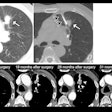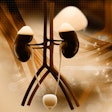In less than a decade, requests for ultrasound-guided interventional procedures have skyrocketed at Thomas Jefferson University as referring physicians choose imaging experts over other clinicians for performing biopsies and other routine procedures.
Dr. Rick Feld from the university’s teaching hospital reported on his group’s findings at November's RSNA conference in Chicago. The goal was to review the overall procedure volume in ultrasound-guided interventional procedures, and to quantify the type of referrals.
"We reviewed our computer database over the past five years and included all interventional procedures performed by our ultrasound radiologists during that five-year calendar period," Feld said. "All procedures were performed in our institution by an attending radiologist with or without the assistance of a house officer, either a radiology resident or fellow."
Based on billing codes, Feld identified the total number of procedures performed for each calendar year and identified the type of procedure. He and his co-authors then calculated the change from each consecutive year compared to the prior year, as well as the change in volume from 1995 to 1999.
What Feld found was a steady and significant increase in demand for several ultrasound-guided interventional procedures such as thyroid biopsy.
"In 1995 we performed 71 thyroid biopsies," he said. "In 1999 we performed 397 biopsies of the thyroid gland. The thyroid biopsies for the yearly period increased by 63% from 1995 to 1996, and 35% between 1996 and 1997. From 1995 to 1999, we’re talking about a 459% increase in thyroid biopsies."
The group also calculated increases in other types of procedures: Abdominal biopsies rose by 394% over the five-year period, random core liver biopsies went up by 57%, and thoracentesis procedures rose 4%.
One reason for the increase is that physicians are referring more and more routine procedures to interventional radiologists rather than to other specialists, Feld said. He cited the example of a patient who had abdominal fluid from a gastrointestinal carcinoma. Rather than sending the patient to a gastroenterologist, the treating physician went with an ultrasound-guided procedure instead.
"We were doing a routine paracentesis," he said. "This is a no-brainer, but this [gastroenterology procedure] was referred to us by an oncologist."
Thoracentesis is another area where the ultrasound-guided interventional radiologists have gained some ground on surgeons, Feld said, suggesting that the imaging aspect might be influencing the referring physicians’ decision. If a traditional, non-imaged thoracentesis had gone awry, a surgeon would be required to insert a chest tube and the patient would have to stay overnight, he noted.
However, there are some areas still dominated by non-radiologists at his institution: Nephrologists always perform random biopsies of the kidneys unless a focal renal mass is present, Feld said.
While the greater demand for image-guided procedures is certainly a boon for the department, it does raise potential conflicts that still need to be addressed, he concluded.
"Will the added cost of imaging be cheaper than the potential cost of complications?" Feld asked. "There are also turf issues, such as the use of ultrasound by clinical services to perform what is perceived as their procedure, such as a core biopsy of the liver."
By Shalmali Pal
AuntMinnie.com staff writer
January 8, 2001
Related Reading
Who's performing interventional spine procedures?, November 30, 2000
Rosy job market ahead for interventional radiologists, November 30, 2000
Click here to post your comments about this story. Please include the headline of the article in your message.
Copyright © 2001 AuntMinnie.com



















